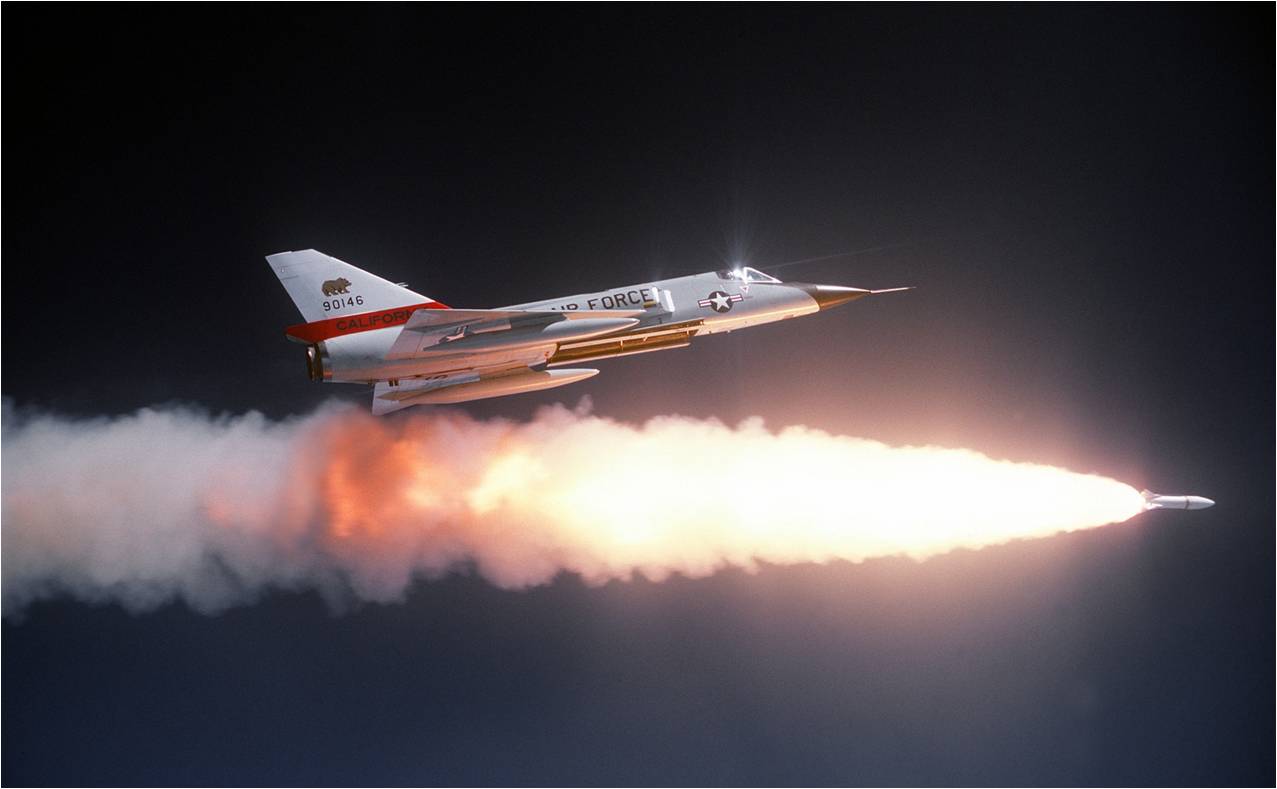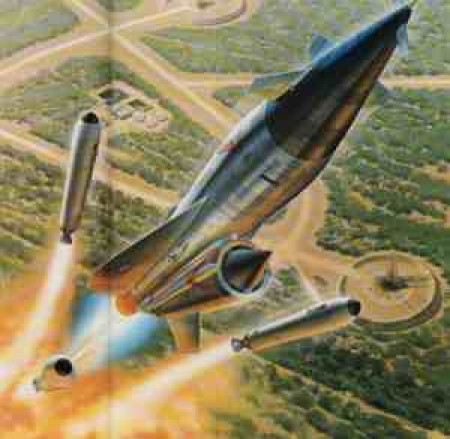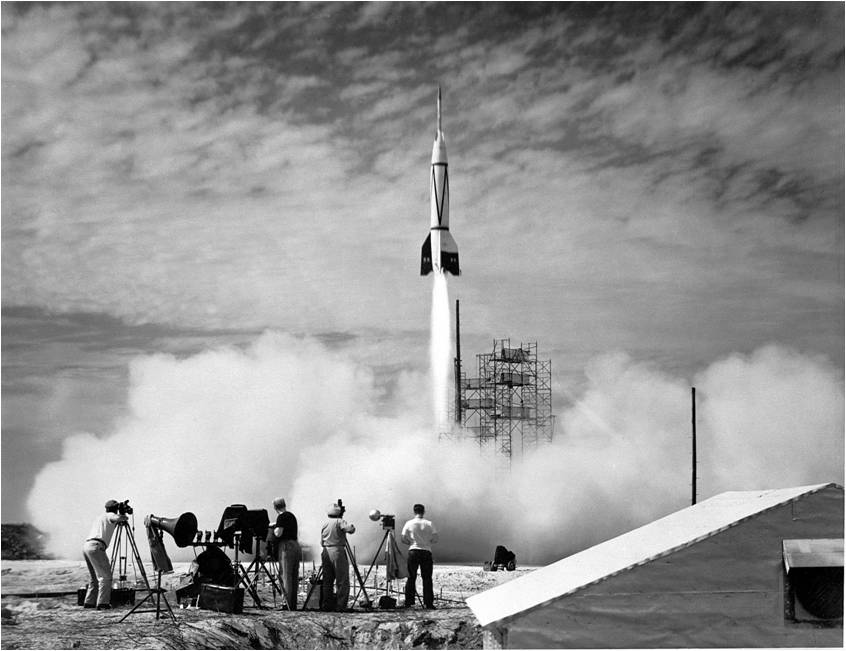
Forty-seven years ago today, the United States successfully orbited the world’s first geosynchronous communications satellite. This accomplishment marked the advent of today’s massive global communications market.
A geosynchronous orbit is one in which the orbital period of a satellite is equal to the time it takes the Earth to complete one revolution about its rotational axis. That is, the satellite completes one revolution around the Earth in slightly less than 24 hours. The altitude for such an orbit is 22,300 miles.
A geostationary orbit is a geosynchronous orbit that lies in the Earth’s equatorial plane. A peculiarity of a geostationary orbit is that the satellite’s position above the Earth remains fixed. Three (3) satellites equally spaced around the Earth in geostationary orbit are within direct line-of-sight of each other. Earth-based stations can use this arrangement to relay radio, television and other signals to any point on the globe.
The Hughes Aircraft Company in California began working on a concept for a geosynchronous satellite in early 1959. A trio of Hughes engineers (Harold Rosen, Thomas Hudspeth and Donald Williams) ultimately came up with a workable geosynchronous satellite design. It became known as Syncom – Synchronous Communications Satellite.
Syncom was cylindrical in shape. It measured 28 inches in diameter and had a height of 15.35 inches. The satellite weighed about 150 pounds fully fueled. Syncom’s external surface was covered with solar cells for power generation with nickel-cadmium batteries used for power storage. Syncom was spun about its symmetry axis for stabilization. Attitude control was provided by an array of nitrogen thrusters.
Syncom 1 was launched on Thursday, 14 February 1963 from Cape Canaveral, Florida. Unfortunately, the spacecraft’s signal was lost during the final boost to geosynchronous orbit. The loss of signal was attributed to an electrical failure. Later, ground-based telescope observations confirmed that the satellite had achieved a near-geosynchronous orbit.
Syncom 2 was launched from Cape Canaveral’s LC-17A at 14:38 UTC on Friday, 26 July 1963. A NASA Thor-Delta B provided the ride into orbit. Syncom’s 1,000-pound thrust apogee motor was used for the final ascent to a quasi-geosynchronous orbit. Over a period of several weeks, the satellite was nudged into a true geosynchronous orbit.
Syncom 2’s geosynchronous orbit was inclined 33 degrees with respect to the Earth’s equator. Thus, the resulting orbit was not geostationary. Coupled with the Earth’s rotation, the spacecraft actually moved in a figure-8 pattern over the globe that tracked 33 degrees north and south of the equator.
Syncom 2 went into active service on Friday, 16 August 1963. The satellite went on to perform brilliantly in its intended role as a communications link. A companion satellite, Syncom 3, was launched on Monday, 19 August 1964 and subsequently joined Syncom 2 in geosynchronous orbit. Significantly, Syncom 3 was used to broadcast the 1964 Tokyo Summer Olympics to America.
Syncom 2 and 3 continued to provide intercontinental communications across the Pacific Ocean until 1966. Increasingly more sophisticated and capable satellites followed. The communications revolution that Syncom started has grown to the point where there are now several hundred communications satellites operating in geosynchronous orbit about the Earth. While long silent, Syncom 2 and 3 continue to orbit the Earth today.

Fifty-three years ago today, the United States successfully conducted the only live-fire test of the only known nuclear-armed air-to-air missile ever developed by the West. The test took place over the Nuclear Test Site located at Yucca Flats, Nevada.
The Cold War between the Soviet Union and the United States gave rise to the development of myriad nuclear weapons. Both superpowers ultimately relied on a triad of platforms, consisting of bombers, missiles and submarines, to deliver nuclear ordnance. Each side used these same types of platforms in a defensive role as well.
The United States employed land-based interceptor aircraft for defending against the Soviet bomber threat. These aircraft would go out to engage and destroy Soviet bomber groups before the latter could penetrate US airspace. The weapon of choice for taking out the bombers was the air-to-air missile.
The most fearsome of air-to-air missiles was armed with a nuclear warhead. The idea was simple. A defending aircraft would fire the nuclear-armed missile into a bevy of Soviet bombers. Detonation of the warhead would in theory destroy an entire bomber group with a single atomic blast.
The Douglas Aircraft Company produced just such a missile for the United States Air Force in the mid-1950’s. The subject missile was originally known as the MB-1 Genie (aka Bird Dog, Ding-Dong, and High Card). The type’s 1.5 kiloton nuclear device had a blast radius on the order of 1,000 feet.
The Genie measured 9.67 feet in length and had a nominal diameter of 17.5 inches. Firing weight was 822 pounds. Genie’s Thiokol SR49-TC-1 solid rocket motor had a rated thrust of 36,500 pounds. The resulting high thrust-to-weight ratio allowed the missile to quickly accelerate to the target. Genie had a top Mach number of 3.3 and a range of slightly over 6 miles.
Genie was carried by the top USAF interceptor aircraft of its day; the Northrop F-89 Scorpion, McDonnell F-101B VooDoo and Convair F-106 Delta Dart. The missile was unguided. That is, Genie was simply a point and shoot weapon. The warhead would detonate only after rocket motor burnout. This delay permitted the carrier aircraft to quickly depart the area following launch.
The only in-flight detonation of a Genie warhead occurred during the summer of 1957 as part of Operation Plumbbob. This program was series of nuclear weapons tests conducted from May to October of the subject year at the Yucca Flats Nuclear Test Site in Nevada.
At 1400 UTC on Friday, 19 July 1957, USAF Captain Eric Hutchison fired a single Genie missile from his Northrop F-89J aircraft. The missile’s W25 warhead detonated at 15,000 feet above ground level shortly after rocket motor burnout. A group of USAF officers was positioned directly below the air burst to prove that the missile could be used over populated areas. The men were reported to be unharmed.
Genie was never used in anger. Approximately 3,150 missiles were produced by the time Thiokol closed down the production line in 1963. This production run included a number of improved variants known as the MB-1-T, ATR-2A, AIR-2A and AIR-2B. Genie ultimately served with both the USAF and the Canadian Air Force. It was withdrawn from service in 1985.

Forty-six years ago this month, the United States abandoned a 7-year effort to develop a nuclear-armed, supersonic cruise missile. The joint USAF-AEC program was known as Project Pluto. The centerpiece of this program was the nuclear-fueled, ramjet-powered Supersonic Low-Altitude Missile (SLAM).
The 1950’s saw the development of myriad aircraft, missile and submarine concepts designed for delivery of nuclear weaponry over strategic distances. This developmental activity was driven by the escalating Cold War between the United States and the Soviet Union. In addition to weapons, the power of the atom was also considered for propulsion applications during this era.
SLAM was perhaps the most fearsome weapon ever conceived. The missile was designed to deliver as many as 26 nuclear bombs over the Soviet Union in a single mission. It would do this while flying at Mach 3 and less than 1,000 feet above ground level. SLAM’s shock wave overpressure alone (162 dB) would devastate structures and people along its flight path. And, as if that were not enough, the type’s nuclear-fueled ramjet would continuously spew radiation-contaminated exhaust all over the countryside.
The SLAM airframe was huge. It measured 88 feet in length, nearly 6 feet in diameter and weighed 61,000 pounds at launch. The vehicle would be fired from a ground-based launch site and accelerated to ramjet takeover speed by a trio of jettisionable rocket boosters. The nuclear-fueled ramjet was rated at 35,000 pounds of thrust.
To find its way to the target area(s), the Ling-Temco-Vought (LTV) SLAM would use a guidance system known today as TERCOM – Terrain Contour Matching. At a target, SLAM would eject an atomic warhead upwards from its payload bay. The resulting lofted trajectory gave SLAM time to depart the hot target area prior to weapon detonation. Following completion of its mission, the missile would then ditch itself by diving into a deep ocean graveyard.
The heart of the Project Pluto missile was the nuclear-fueled ramjet. An unshielded nuclear reactor, code named TORY, was devised, built and successfully tested. Testing was conducted at a special-purpose test site in Nevada. In its Tory II-C configuration, the SLAM ramjet produced over 500 megawatts of power in 5 minutes of continuous operation during a test conducted in May of 1964.
SLAM’s nap-of-the-earth, supersonic flight profile would subject the airframe to terrific airloads, vibrations and temperatures. The Project Pluto team successfully devised structural and thermal material solutions to handle the daunting flight environment. In addition, nuclear-hardened electronics and flight controls were successfully developed.
From a technological standpoint, Project Pluto proved to be entirely viable. However, doubts about its implementation started to arise as flight testing of the nuclear-powered missile was seriously considered. Where do you flight-test a radiation-spewing missile? What happens if you can’t turn-off the reactor? What do you do if the guidance system fails? Where do you dispose of the missile after a flight test? These and other disturbing questions began to trouble program officials.
Coupled with the above practical concerns of SLAM flight testing were growing political and mission obsolesence issues. Pentagon officials ultimately deemed Project Pluto as being highly provocative to the Soviet Union in the sense that the communist super power might feel compelled to develop their own SLAM. Further, American missilery was quickly developing to the point where ICBM-delivered warheads would do the job and at a lower per-unit cost.
So it was that on Wedneday, 01 July 1964, Project Pluto was canceled after 7 years of fruitful development. While no airframe was ever built and tested, SLAM technology was applied to a host of subsequent aerospace vehicle developments.
SLAM would truly have been “The Missile From Hell” had it matured to the point of flight. Indeed, the ethical issues concerning the missile’s use were quite sobering. And, owing to Murphy’s Law and its many corollaries, the chances for unintended catastrophe were high as well. Despite the allure of this “technically sweet” solution to a national defense problem, the decision to cancel Project Pluto was ultimately the only correct course to follow.

Sixty-years ago this month, the United States launched a primitive two-stage rocket from an obscure site situated on Florida’s eastern coast. The rocket was the Army’s Bumper-WAC No. 8. The then little-known launch location has since become synonymous with American aerospace achievement. We know it today as Cape Canaveral.
The Bumper Program was a United States Army effort to reach flight altitudes and velocities never before achieved by a rocket vehicle. The name “Bumper” was derived from the fact that the lower stage would act to “bump” the upper stage to higher altitude and velocity than it (i.e., the upper stage) was able to achieve on its own.
The Bumper two-stage configuration consisted of a V-2 booster and a WAC Corporal upper stage. The V-2′s had been captured from Germany following World War II while the WAC Corporal was a single stage American sounding rocket. The launch stack measured 62 feet in length and weighed around 28,000 pounds.
From a propulsion standpoint, the V-2 booster generated 60,000 pounds of thrust with a burn time of 70 seconds. The WAC Corporal rocket motor produced 1,500 pounds of thrust and had a burn time of 47 seconds.
The first Bumper-WAC shots took place at White Sands Proving Ground (WSPG) in New Mexico. The first six (6) flights were dedicated to achieving maximum altitude. Indeed, Bumper-WAC No. 5 flew to an altitude of 250 miles on Thursday, 24 February 1949.
WSPG could not be used for the last two (2) flights which required the Bumper-WAC vehicle to remain within the atmosphere. A larger range was required to handle these missions which involved a significant amount of essentially horizontal flight. Looking beyond Bumper, it was clear that future programs would also require a much larger test range as well.
After considering a number of geographical locations within the US, the new Long Range Proving Ground (LRPG) was ultimately established in the state of Florida. The LRPG locale was hot, bug-infested and covered with sand dunes and scrub palmetto. However, the LRPG was also immediately adjacent to the Atlantic Ocean which provided a vast region over which test rockets could be safely flown.
Bumper-WAC No. 7 was supposed to be the first rocket fired from the LRPG. However, Bumper-WAC No. 8 got that honor when No. 7 experienced a glitch on the pad. No. 8 was fired at 13:29 UTC on Monday, 24 July 1950. The mission failed when the rocket motor of the WAC upper stage did not ignite.
On Saturday, 29 July 1950, Bumper-WAC No. 7 was launched from the LRPG. The mission was entirely successful. The WAC upper stage burned-out at Mach 9 and flew 150 miles downrange. The maximum sustained velocity within the atmosphere was more than 3,200 mph – a record for the time.
While the Bumper Program would fade into history, the LRPG did not. History records that the fledging test facility would develop into America’s preeminent launch complex. The military services would grow both our Nation’s missile defense and space launch vehicle capabilites there. Later, NASA would come on the scene and send astronauts first into Earth orbit and then to the Moon.
Cape Canaveral now operates in a season of decline relative to our national space effort. The fabled Space Shuttle will soon be retired. The CEV Program is slated for cancelation, leaving our country without either a national manned launch vehicle or spacecraft. Very soon, we will not even be able to go to and from our own space station. The prevailing “wisdom” is that private industry will solely provide access to space in the future. And such is to be accomplished without any national system being available as a back-up.
That we as a nation find ourselves in the predicament outlined above, is at once ironic and obscene. However, this is America and we are Americans. And, despite determined and increasing assaults from without and from within, we are still a land of liberty and opportunity. We can chose a better path.
Whether Cape Canaveral has seen its best days or if those that lie ahead will be better still, it is up to the citizens of the United States to determine. The responsibility and obligation to do so can neither be evaded nor avoided. If we chose rightly, Cape Canaveral’s, and indeed our beloved country’s, best days await in the future.
To both we say with deepest sentiment: “Long may you run.”





